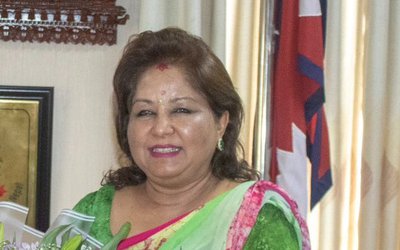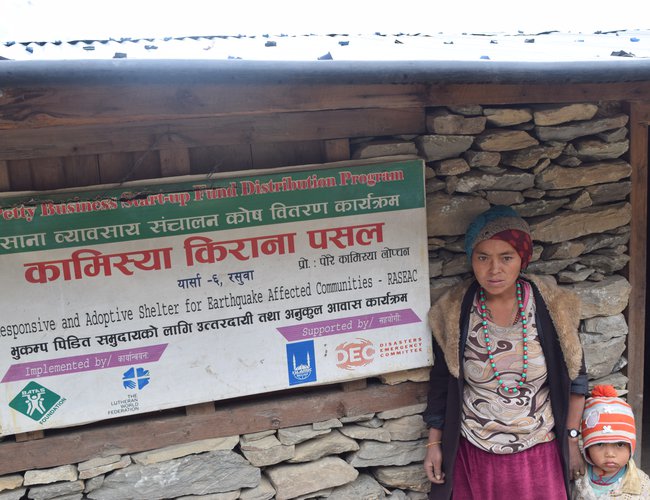
With the construction of shelters, toilets and the rehabilitation of infrastructures like irrigation canal, drinking water and livelihood support in on farm and off farm, trauma and pain of earthquake devastation is now issue of past for the majority of the residence who received support.
Under on farm and off farm support, the victims learn the way how to generate sustained incomes and continue the profession they chose. Similarly, the restoration and construction of infrastructure with disaster and earthquake resilient under Build Back Better (BBB), the community have now earthquake resilient houses and infrastructures.
Apart from these, the establishments of institutional set up like Disaster Emergency Fund, Local Level Disaster Committee and awareness campaigns are other achievements of last three years. What one see now that people are better prepared for disasters and living with safe and inclusive shelters and infrastructures with resilient livelihood options. Even people have started to grow climate change resilient crops.
Construction of inclusive and friendly toilets to people with disability toilets and Community bathing for women, the project has taken extreme care to all the people in community. These kinds of projects sensitize community about the gender, people with disability, elderly and children.
The earthquake devastated badly the life of fifty years old Kaisya Tamang, a resident of Kalika Rural Municipality – 1, Ramche of Rasuwa District. Her house was demolished and property destroyed as well. However, the construction of inclusive toilet solves her needy problems.
In all its program and projects, priorities were given to single women, children, and people with disability. Implemented by LWF Nepal in partnership BATAS Foundation supported by IRW-DEC, the projects have turned the villages from risky and vulnerable place for disaster to more secure and safe even in terms of livelihood and infrastructure.
When LWF Nepal has begun its emergency response in different villages of Rasuwa immediately after the quake, the villages were in dire needs of reconstruction and rehabilitation as almost all shelters, drinking water sources, irrigations systems were either damaged or washed out. And people were in desperation.
Implemented by LWF Nepal in partnership BATAS Foundation supported by IRW-DEC, the project, which supported shelter and livelihood for earthquake victims representing marginalized, indigenous, poor and dalits community, has turned the village disaster resilient and safe. Working closely with community, government agencies and locally elected representatives, all the works have done with complete collaboration with stake holders. As the projects were selected, design and implemented with the contribution of local community and elected bodies, people have strong sense of ownership. Even livelihood programs, local community set the criteria and decided to beneficiaries and individuals for training and grant.
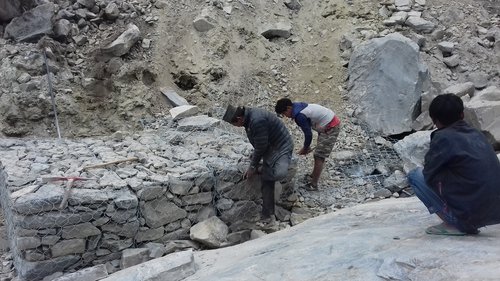 When the earthquake struck, they were leaving in
unsafe shelters. Now people have new earthquake resilience shelters and
infrastructures like irrigation, trails, drinking water and toilets built
through Build Back Better (BBB) approach and even means for sustained and
climate change resilient livelihood. Since the projects were implemented under
a close coordination and involvement of local community, elected local level
and district level government offices, there established linkage between
government service delivery institutions like Livestock, District Agriculture
Development Office, and District Cottage Industry Office. Since the linkage
have already established, the district level levels government’s service
delivery offices are supporting the projects with their technical knowhow. This
ultimately benefits beneficiaries.
When the earthquake struck, they were leaving in
unsafe shelters. Now people have new earthquake resilience shelters and
infrastructures like irrigation, trails, drinking water and toilets built
through Build Back Better (BBB) approach and even means for sustained and
climate change resilient livelihood. Since the projects were implemented under
a close coordination and involvement of local community, elected local level
and district level government offices, there established linkage between
government service delivery institutions like Livestock, District Agriculture
Development Office, and District Cottage Industry Office. Since the linkage
have already established, the district level levels government’s service
delivery offices are supporting the projects with their technical knowhow. This
ultimately benefits beneficiaries.
From the few days after the earthquake till the present phase, LWF Nepal continued its support. In the first phase, it was relief materials for emerge purpose. Under Responsive Adaptive Shelter for Earthquake Affected Community (RASEAC)’ project, LWF with BATAS Foundation and in support from Islamic Relief Worldwide (IRW) and Disaster Emergency Committee (DEC) constructed 151 houses, repaired drinking water system and provided support on livelihood restoration in partnership.
Following successfully implementing second phases, Lutheran World Federation Nepal (LWF-Nepal) in partnership with BATAS Foundation and IRW has implemented ‘DEC Phase 2 (B) project building on experience of the success, lesson learned and methodology of the RASEAC Project.
After closing of DEC Phase 2b project at the end of April, there is now enhanced diversified and resilient livelihood options of targeted households and people have improved and equitable access to safe drinking water, sanitation facilities. With water and toilet, people have demonstrated change in hygiene behavior. The project also strengthened community resilience and mainstreaming of DRR and CCA in livelihood, community infrastructure and WASH.
Mainstreaming BBB
One can easily see mainstreaming the BBB approach and the best practices in all projects. They included Disaster Risk Reduction (DRR), community recovery and effective implementation. All infrastructures and livelihood programs were designed looking at the DRR. Under the DRR, whatever infrastructure were built, all of them are disaster including earthquake resilience.
The project ensured the BBB approach in each of the sectorial response during the implementation of projects. Unlike other disaster projects, this project incorporated all the elements of the BBB approach beyond infrastructure construction.
In the construction of shelters and infrastructures, the project studied multi-hazard land use model as well. Doing this the project avoided landslide prone areas. Even in those areas where they cannot avoid such place, the proper mitigation efforts are taken.
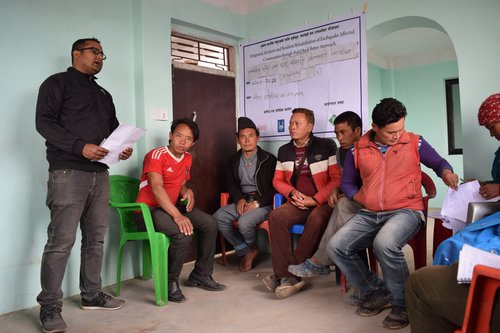 The water taps were constructed to provide equitable
access and help the social recovery process. As water taps were constructed in
the middle of community. beneficiaries can reach within 10 minutes in all the
water taps constructed in the areas. With the involvement of community, local
elected representatives and governments, the projects supported community
recovery through effective implementation. Through the effective
implementation, there mainstreams BBB in all projects.
The water taps were constructed to provide equitable
access and help the social recovery process. As water taps were constructed in
the middle of community. beneficiaries can reach within 10 minutes in all the
water taps constructed in the areas. With the involvement of community, local
elected representatives and governments, the projects supported community
recovery through effective implementation. Through the effective
implementation, there mainstreams BBB in all projects.
Inducting disaster preparedness and awareness in the programs, the project gave due consideration to DRR and it added mitigation approach to minimize the risk. Under recovery, the project analyzed the multiple land hazards and selects the place for infrastructures construction which is safe. The projected avoided the landslide prone areas as much as possible. If there is no option, proper mitigation measures were taken. In the past community generally allocated the wasted public land to build the infrastructures which were always vulnerable to disasters.
Learning lesions from the past, the project built infrastructures in the safest place as community themselves is very sensitive about the disasters. People allocated the land with the recommendation of the technicians. This indicated that community also wants to see sustainable infrastructures. This is because of the higher awareness of disasters in the community generated through its programs.
Under the economic livelihood recovery in the on farm, the project implemented poultry and vegetable farming. However, the project provided knowledge and skill related to the program and has made linkage with the district level government institution. Although people in the community had poultry before the earthquake, they didn’t’ know the risk involve on it and the district level technical support office. Now poultry farmers were given entire process of raring the chicken, medicine and market as well. In the past, many farmers gave away poultry because of incurring loss and move to mason and labor work. Following the implementation under the earthquake recovery, the situation has changed. Farmers were given proper training and people know where to get the technical support when there appear problems. As the entire process developed following strictly Core Humanitarian Standard On Quality and Accountability, all the programs and projects were planned, designed and implemented through participatory approach.
Through effective implementation, the project supported the institutional mechanism like stake holder management and community consultation. All the projects were planned, designed and implemented through participatory. As the projects were for community, the project constructed infrastructures under the community’s recommendation. From survey to project design and implementation, there is active participation of community. The project did joint monitoring of all projects with community user group, various level of locally elected representative including head of Rural Municipality, ward chairs, ward members and government offices. The project followed compliance legislation as well.
So far as the complains were concerned, the projects welcomed all kinds of complains received through verbal, written by phone, post office or other methods. The project addressed all of them. There also involve accountability mechanism. The project developed a system of public audit and different stake holders were invited in various stages. Although there are several concepts of BBB, the project incorporated and integrated all of them during the process of implementation.
What has been done by the project from the climate adaptive recovery responses?
As Nepal is one of most climate vulnerable country occurring highest numbers of climate induced disasters every year. The fluctuation of temperature has already started to affect the traditional agriculture product which will likely to create severe problems food security in future. Under climate adaptive recovery response, the project encouraged farmers to plant Garlic in Arukharka village with commercial purposes. The project consulted expert from DADO about the viability of garlic farming in the region. After the recommendations of DADO, the project supported the garlic farming as a climate adoptive crop. The project also provided farmers necessary training. To prevent soil erosion, the project also encouraged farmers to go for multiple farming and provided multiple agro training. The project provided seeds and fertilizer. Doing this, they adhered the climate change and adaptation. Never in the history, the farmers ever planted the garlic; the garlic farming is a new innovation in the area.
Funding Instrument
The funding is very effective and properly utilized
as per the needs of the farmer and maximized the investment. 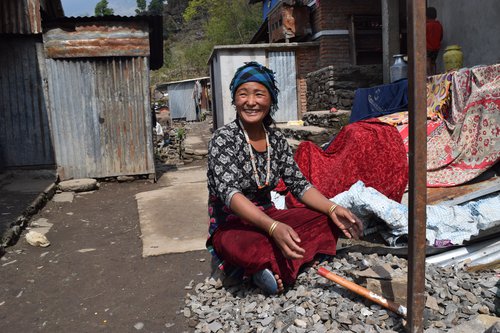 Although the
support was very small, the fund motivated the farmers. In the on farm and off
farm, the beneficiaries even invested from their own taking even loan. In
infrastructure restoration and construction and institutional building,
community and local level also added their contribution. Most important parts
of funding are that it helped to develop the ownership on the project by local
community. Although the project provide 38,000 rupees support for off far and
on farm., community has also contributed through loan or own investment taking
as a matching fund for way forward. What is important is the linkage establish
by the project between the government office, market and farmers. Through the
project arrangements, community members visited Nuwakot to show their products
and the DADO’s officials were taken to site visit to interact with farmers. In
the construction of toilets, shelters, irrigation schemes, water tap and trail,
the fund was to use. Similarly, the fund provided to on farm and off farm,
institutional building and Emergency Disaster Fund, they are matched by local
farmers and local levels. Naukunda Rural Municipality has shown example how
collaboration with civil society organization is possible donating in the
drinking water project and Disaster Fund.
Although the
support was very small, the fund motivated the farmers. In the on farm and off
farm, the beneficiaries even invested from their own taking even loan. In
infrastructure restoration and construction and institutional building,
community and local level also added their contribution. Most important parts
of funding are that it helped to develop the ownership on the project by local
community. Although the project provide 38,000 rupees support for off far and
on farm., community has also contributed through loan or own investment taking
as a matching fund for way forward. What is important is the linkage establish
by the project between the government office, market and farmers. Through the
project arrangements, community members visited Nuwakot to show their products
and the DADO’s officials were taken to site visit to interact with farmers. In
the construction of toilets, shelters, irrigation schemes, water tap and trail,
the fund was to use. Similarly, the fund provided to on farm and off farm,
institutional building and Emergency Disaster Fund, they are matched by local
farmers and local levels. Naukunda Rural Municipality has shown example how
collaboration with civil society organization is possible donating in the
drinking water project and Disaster Fund.
Enablers and Barriers to mainstream BBB approach
Along with enablers. there were certain barriers as well. As the project implemented to two remote villages of Naukunda and Kalika, building resilient infrastructures under BBB and equitable access remained geographically challenging. As geology and topography of this area prone to soil erosion, there was a history of frequent landslides. Despite efforts to avoid the landslide prone areas, the project cannot change the water sources in some places. In some areas pipeline and alignments are passing from landslide risk areas. In these areas, the project supported mitigation approach to reduce the risk. As the communities are unaware about hazard part of project sites, they have shown less interest in mitigation efforts. As the mitigation measures are essential for the protection, the project built Gabon walls, erected polls to bring the pipelines from above as mitigation measures to protect the infrastructures.
Stakeholders On BBB approach
As the projects planned, designed and implemented with close coordination with Rural Municipalities and communities, other stake holders also promoted the BBB approach. Communities accepted the BBB approach in building shelters and planting vegetables and setting up the funds. Naukunda Rural Municipality is an example where the project contributed Rs. 80,000.00 to set up emergency disaster fund. However, the Rural Municipality reciprocated adding Rs. 1 million. According to new Disaster Management Act, the local bodies are given numbers of important responsibility but they are not in a position to fulfill them. Looking at this, the project conducted training related to climate change and disaster. supporting to set up Local Level Climate Change and Disaster Committee to cope future disaster and hazard. The project prepared the community and locally elected body to handle the disaster before any international agencies come to see them. The project trained local level leaders and trained them how to carry out immediate relief and evacuation during the disaster.
Policy Level Change To promote BBB approach
Infrastructures were constructed even in the past. The government built house and drinking water taps, toilet and roads and irrigation. After the earthquake, the everyone has realized that there need to bring change in design, standard while implementing the infrastructures. The project stressed BBB because it considered that infrastructure should be sustainable. There need to increase awareness, regular maintenance and sense ownership of local community to promote the BBB approach. Although the new Disaster Act and policy more friendly to community and local level, the proper step is yet to taken to empower them. After the earthquake, there is a growing realization for the need to change design and infrastructure because most of the house and other infrastructure build in the past collapsed. Learning the lesion from the past, Lutheran World Federation Nepal (LWF-Nepal) in partnership with BATAS Foundation and IRW-DEC also pursued for policy level changes urging to strengthen the local level in handling disasters.
Following the earthquake Ministry of Federal Affairs, Ministry of Urban and National Reconstruction Authority have developed policy to making BBB approach mandatory. LWF-Nepal, BATAS Foundation and IRW-DEC provided technical and other support at local level and community. For the implementation of NRA’s building code and standard, there need to have capable masons. Providing training to mason at community level, LWF, BATAS and IRW-DEC supported the implementation of BBB approach.
Holding awareness campaigns, there generated the sense of disaster resilience shelter and other infrastructure. They also pursue that new home should be strong because previous house did not stand because they might be weaker in term of construction and design. In the past, many institutions came and built infrastructures. However, people did not own it. If the local population does not have contribution, they might not take ownership. This is the reason LWF seeks the contribution of the community in building the shelter, infrastructure of livelihood component. There need to have policy in building infrastructures showing the role of government, community and NGOs and INGOs.
What would be the suitable framework to enable future response to easily adopt the key elements of BBB in a better way?
Socio-psychological recovery in earliest and safe shelter will be key element compelled community to adopt the BBB in future response. The frame work must be designed to show how sustainable infrastructures are important to protect their own life and property.
Lesson learned
The project has shown that capacity building of community and their involvement in the relief and recovery is key to success. Participatory planning, monitoring and implementation, community needs to involve. Similarly, there need to have coordination among the government institutions including Rural Municipality. There need to increase access of local community to the rural municipality and district office. If this idea is materialize, it will bring major changes in reconstruction and recovery.
On farm and off farm grocery training
Four enterprises have established Given the present experience, all the enterprises are running successful. In both Rural Municipality, LWF has also supported to establish Village Level Disaster Committee. As par the guidelines and disaster management
Coordination with Local Level
The project is working in different sectors including livelihood, wash and DRR. The project has strong coordination and collaboration with stake holders, community, local levels and government institutions. The project has close linkage with district level agriculture, livestock and Cottage Industry, and Drinking Water and Sanitation and NRA’s unit. Similarly, the project also helped local community know what services the government units provide them. Thanks to the effort of the Project, people are aware about the role of district and municipal level units. With the establishment of linkage, DADO and Livestock’s official paid regular visit to the farmers and provide necessary advised and suggestion. This is for the first time people have direct interactions with the local level service delivery institutions. The project also established linkage to district and rural level officials. Two community level farmers groups have already registered to DADO Temrang Agriculture Cooperatives of Ramche registered with DADO and Arukharka Agriculture Cooperatives of Yarsha is in the process of registration with DADO. LWF will for short term it is the community to take all the responsibility. LWF also informed about the emergency number.
Institution Building
LWF supported to build farmers cooperatives and as well as Disaster Management Committee at Rural Municipality. Although the government has already developed guidelines for the establishment of committee, the officials at rural municipality do not know about it. With the support, both the rural municipality has now Disaster Management Committee. Conducting a mock drill in Kalikasthan showing the roles of various institution through simulation.
Although implementation period was very short planned designed and implementation during monsoon, festivals, social rituals and the elections, the project faces several barrier, LWF Nepal, BATAS Foundation an IRW-Dec has been able to complete them successfully. The project is in the phase out stage.

Keshab Poudel
Poudel is the editor of New Spotlight Magazine.
- HELVETAS NEPAL’S RIVERBED FARMING: Shift From Overseas To Local Farming
- Jul 26, 2024
- POLITICAL SCENARIO : K.P. Sharma Oli's Resurgence
- Jul 21, 2024
- UNDP/MinErgy: An Inventive Approach To Clean Brick Kiln
- Jul 19, 2024
- HELVETAS NEPAL: Nutrition Through Riverbed Farming
- Jul 18, 2024
- NOU Opens To All: Dr. Shilu Manandhar Bajracharya, Vice Chancellor
- Jul 15, 2024






